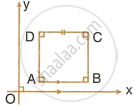Advertisements
Advertisements
प्रश्न
Determine whether the following point is collinear.
A(–4, 4), \[K\left( - 2, \frac{5}{2} \right),\] N (4, –2)
उत्तर
A(–4, 4), \[K\left( - 2, \frac{5}{2} \right),\] N (4, –2)
Slope of AK = `(5/2 - 4)/((-2) - (- 4))`
= `((5 - 8)/2)/((-2) + 4)`
= `((-3)/2)/2`
= `((-3)/2)/(2/1) = (-3)/2 xx 1/2 = (-3)/(2 xx 2)`
= `(-3)/4`
\[\text { Slope of KN } = \frac{(- 2) - \frac{5}{2}}{4 - \left( - 2 \right)}\]
= `(((-4) - 5)/2)/(4 + 2)`
= `((-9)/2)/(6/1) = (- 9)/2 xx 1/6 = (-9)/(6 xx 2) = (- 9)/12`
= `(- 3)/4`
Slope of AK = Slope of KN
Thus, the given points are collinear.
APPEARS IN
संबंधित प्रश्न
The slope of a line joining P(6, k) and Q(1 – 3k, 3) is `1/2`. Find:
- k.
- mid-point of PQ, using the value of ‘k’ found in (i).
The line passing through (0, 2) and (−3, −1) is parallel to the line passing through (−1, 5) and (4, a). Find a.
Without using the distance formula, show that the points A(4, 5), B(1, 2), C(4, 3) and D(7, 6) are the vertices of a parallelogram.
The side AB of an equilateral triangle ABC is parallel to the x-axis. Find the slopes of all its sides.

The side AB of a square ABCD is parallel to the x-axis. Find the slopes of all its sides. Also, find:
- the slope of the diagonal AC.
- the slope of the diagonal BD.

Find the slope and the inclination of the line AB if : A = `(-1, 2sqrt(3))` and B = `(-2, sqrt(3))`
The lines represented by 4x + 3y = 9 and px – 6y + 3 = 0 are parallel. Find the value of p.
Find the slope of the line passing through the points G(4, 5) and H (–1, –2).
Find the slope of the lines passing through the given point.
P (–3, 1) , Q (5, –2)
Determine whether the following point is collinear.
P(2, –5), Q(1, –3), R(–2, 3)
Show that A(–4, –7), B (–1, 2), C (8, 5) and D (5, –4) are the vertices of a parallelogram.
Find the type of the quadrilateral if points A(–4, –2), B(–3, –7) C(3, –2) and D(2, 3) are joined serially.
Find the slope of a line passing through the given pair of points (2,5) and (-1,8)
Find the slope of a line passing through the given pair of points (9,-2) and (-5,5)
Find the slope of a line parallel to the given line 5x-y = 10
Find the slope of the line passing through the points M(4,0) and N(-2,-3).
The line through A (- 2, 3) and B (4, b) is perpendicular to the line 2a – 4y = 5. Find the value of b.
Find the image of a point (-1, 2) in the line joining (2, 1) and (- 3, 2).
If A(6, 1), B(8, 2), C(9, 4) and D(7, 3) are the vertices of `square`ABCD, show that `square`ABCD is a parallelogram.
Solution:
Slope of line = `("y"_2 - "y"_1)/("x"_2 - "x"_1)`
∴ Slope of line AB = `(2 - 1)/(8 - 6) = square` .......(i)
∴ Slope of line BC = `(4 - 2)/(9 - 8) = square` .....(ii)
∴ Slope of line CD = `(3 - 4)/(7 - 9) = square` .....(iii)
∴ Slope of line DA = `(3 - 1)/(7 - 6) = square` .....(iv)
∴ Slope of line AB = `square` ......[From (i) and (iii)]
∴ line AB || line CD
∴ Slope of line BC = `square` ......[From (ii) and (iv)]
∴ line BC || line DA
Both the pairs of opposite sides of the quadrilateral are parallel.
∴ `square`ABCD is a parallelogram.
What is the name of the point of intersection of coordinate axes?
